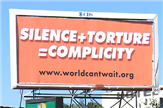|
We tend to focus on Guantanamo, but it represents the tip of the iceberg... many thousand detainees held within Iraq and elsewhere. According to the following story,
The U.S. military is rushing to build criminal cases ahead of 2009 |
Detainees are seen outside their cell block at the U.S. detention facility at Camp Cropper in Baghdad, Iraq, on Nov. 10. |
CAMP CROPPER, Iraq - The U.S. military is rushing to build criminal cases against some 5,000 detainees it deems dangerous -- including suspected members of al-Qaida in Iraq -- because the proposed security pact with Iraq would end its right to hold prisoners without charge.
The agreement, which is to be voted on by Iraqi lawmakers Wednesday, is primarily intended to set a timetable calling for American troops to leave Iraq by the end of 2011. But it also calls for control of security matters to shift to Iraqi authorities.
If passed, the deal would mean U.S. troops could no longer hold people without charge as they have since the 2003 invasion that ousted Saddam Hussein. Beginning Jan. 1, all detentions would have to be based on evidence, and the U.S. would have to prosecute prisoners in Iraqi courts or let them go.
Evidence in only a few hundred cases
The Americans have evidence against only "a few hundred" of the most dangerous detainees, Quantock said, leaving open the possibility that thousands could find themselves back on Iraq's streets soon.
"We have a lot of work to do," he said.
Part of the challenge stems from differences between the U.S. and Iraqi legal systems. In the United States, forensic evidence is widely used in the courts. Not so in Iraq.
"We've got a number of guys right now that are covered in TNT (explosive residue). However, that's not admissible in Iraqi court," Quantock said. "What wins the day in Iraqi courts today is two eyewitness statements or a confession."
The U.S. is training Iraqi forensic specialists and pushing to make such evidence more acceptable in court. Iraqi judges are slowly bending, but it is expected to take time before forensic evidence wins wide approval.
The transition comes amid a marked improvement in security that has boosted the confidence of Iraq's government and allowed security-based detention to give way to a civilian justice system. It would also mark a major step toward shutting down a detention system that was tainted by the scandal at Abu Ghraib prison outside Baghdad, where U.S. guards abused detainees.
Most detainees not considered dangerous
U.S. forces are holding around 16,500 detainees in all. The largest facility, with some 12,900 prisoners, is at Camp Bucca near the city of Basra, some 340 miles southeast of Baghdad.
Camp Cropper, on the sprawling U.S. base near Baghdad International Airport outside the capital, serves as the system's logistical headquarters and houses some 2,000 prisoners. All detainees entering and leaving U.S. custody pass through Cropper.
On a recent trip to the base, Associated Press journalists saw detainees dressed in yellow pants and shirts or traditional robes chatting outside low-slung, peach-colored barracks. Some ritually washed their hands and feet before afternoon prayers, while others set out laundry to dry in the midday sun. Guards kept watch from towers looming over a double row of barbed-wire fences.
The vast majority of those in U.S. custody are not considered dangerous, so the military is focusing its legal efforts on the 5,000 it deems a threat.
Iraq's government will receive the names and other details of those in U.S. custody so it can issue arrest warrants for some of them. Quantock said he is confident that either the U.S. or Iraqi government will muster enough evidence to keep many of the most dangerous individuals behind bars.
Releasing detainees poses challenge
But releasing the other 11,000 prisoners, who are not considered a serious threat, also poses a challenge.
The security agreement before Iraq's parliament stipulates that detainees be let go "in a safe and orderly manner"...
http://www.msnbc.msn.com/id/27874735/


